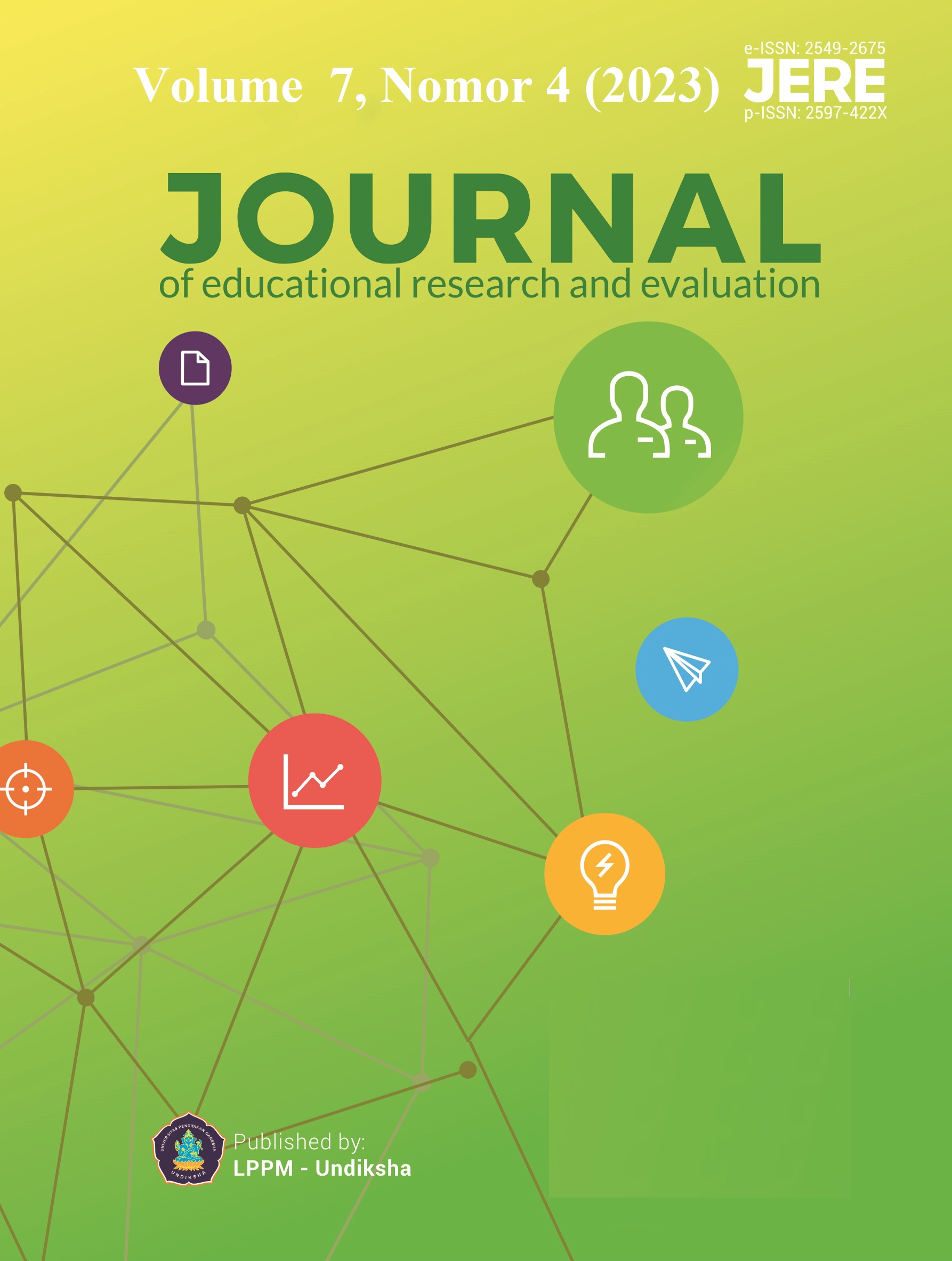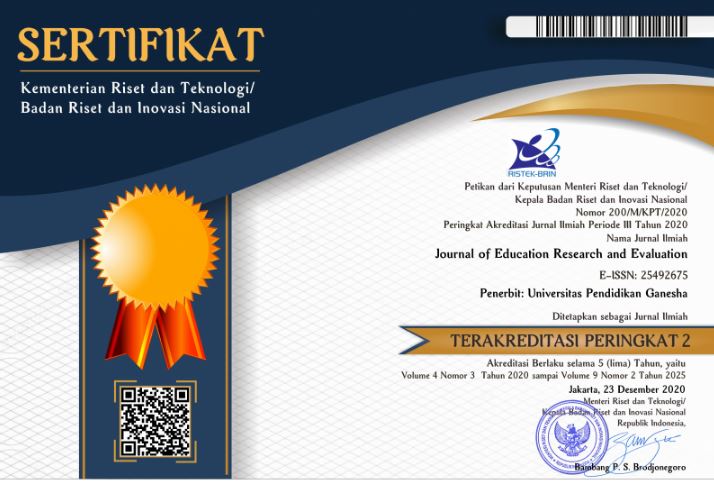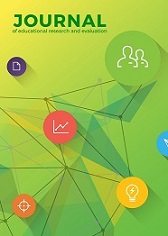Taking Up the Challenges Faced by Higher Education Institutions in Technology to Create Smart Campus
DOI:
https://doi.org/10.23887/jere.v7i4.66851Keywords:
Higher Education, Challenges, Technology, Smart CampusAbstract
Universities face big challenges in technology to create smart campuses to increase higher education efficiency, productivity, quality and innovation. This research aims to analyze universities' efforts to utilize technology to create smart campuses. The research uses descriptive qualitative with a phenomenological approach. Data was collected through open interviews at four universities. Research subjects include top level management, middle level management, lecturers and staff. Data analysis was performed using Bogdan & Biklen which is called data reduction, the interconnection between data and verification. The research results show that universities have made various efforts to introduce digital technology to create smart campuses. This research describes the ability of universities to realize Smart Campus in 4 levels, namely adoption, implementation, integration and optimization. However, the biggest challenge is the integration and optimization of systems used for education, research and service services. Then optimization requires policies that involve goals and targets related to integration, technological sustainability and improving the learning environment, so that it will create a smart campus.
References
Abbas, J. (2020). HEISQUAL: A modern approach to measure service quality in higher education institutions. Studies in Educational Evaluation, 67(January), 100933. https://doi.org/10.1016/j.stueduc.2020.100933.
Abuhmaid, A. (2011). Ict training courses for teacher professional development in jordan. Turkish Online Journal of Educational Technology, 10(4). https://eric.ed.gov/?id=EJ946628.
Ahmad, T. (2019). Scenario based approach to re-imagining future of higher education which prepares students for the future of work. Higher Education, Skills and Work-Based Learning, 10(1), 217–238. https://doi.org/10.1108/HESWBL-12-2018-0136.
Arisandi, D., Setiawan, D., Karpen, K., & Musyafak, M. (2022). Perancangan Media Pembelajaran Topologi Jaringan dengan Augmented Reality di Program Studi Teknik Informatika. EDUKATIF : JURNAL ILMU PENDIDIKAN, 4(1), 1487–1497. https://doi.org/10.31004/edukatif.v4i1.2231.
Attard, C., & Holmes, K. (2022). An exploration of teacher and student perceptions of blended learning in four secondary mathematics classrooms. Mathematics Education Research Journal, 34(4), 719–740. https://doi.org/10.1007/s13394-020-00359-2.
Bae, Y., Bhattacharya, S., Cui, B., Lee, S., Li, Y., Zhang, L., Im, P., Adetola, V., Vrabie, D., Leach, M., & Kuruganti, T. (2021). Sensor impacts on building and HVAC controls: A critical review for building energy performance. Advances in Applied Energy, 4(June), 100068. https://doi.org/10.1016/j.adapen.2021.100068.
Barker, M., Olabarriaga, S. D., Wilkins-Diehr, N., Gesing, S., Katz, D. S., Shahand, S., Henwood, S., Glatard, T., Jeffery, K., Corrie, B., Treloar, A., Glaves, H., Wyborn, L., Hong, N. P. C., & Costa, A. (2019). The global impact of science gateways, virtual research environments and virtual laboratories. Future Generation Computer Systems, 95, 240–248. https://doi.org/10.1016/j.future.2018.12.026.
Bhushan, B., Sinha, P., Sagayam, K. M., & J, A. (2021). Untangling blockchain technology: A survey on state of the art, security threats, privacy services, applications and future research directions. Computers & Electrical Engineering, 90(October), 106897. https://doi.org/10.1016/j.compeleceng.2020.106897.
Blau, I., Shamir-Inbal, T., & Avdiel, O. (2020). How does the pedagogical design of a technology-enhanced collaborative academic course promote digital literacies, self-regulation, and perceived learning of students? Internet and Higher Education, 45(May 2019), 100722. https://doi.org/10.1016/j.iheduc.2019.100722.
Bond, M., & Bedenlier, S. (2019). Facilitar la participación de los estudiantes a través de la tecnología educativa: hacia un marco conceptual. Journal of Interactive Media in Education, 2019(1), 1–14. https://fh.mdp.edu.ar/encuentros/index.php/jie/2jie/paper/viewPaper/574.
Chan, C. K. Y. (2023). A comprehensive AI policy education framework for university teaching and learning. International Journal of Educational Technology in Higher Education, 20(1), 38. https://doi.org/10.1186/s41239-023-00408-3.
Chatterjee, I., & Chakraborty, P. (2021). Use of Information Communication Technology by Medical Educators Amid COVID-19 Pandemic and Beyond. Journal of Educational Technology Systems, 49(3), 310–324. https://doi.org/10.1177/0047239520966996.
Chryssou, C. E. (2020). University–industry interactions in the Sultanate of Oman: Challenges and opportunities. Industry and Higher Education, 34(5), 342–357. https://doi.org/10.1177/0950422219896748.
Cohen-Shacham, E., Andrade, A., Dalton, J., Dudley, N., Jones, M., Kumar, C., Maginnis, S., Maynard, S., Nelson, C. R., Renaud, F. G., Welling, R., & Walters, G. (2019). Core principles for successfully implementing and upscaling Nature-based Solutions. Environmental Science & Policy, 98(June 2018), 20–29. https://doi.org/10.1016/j.envsci.2019.04.014.
Cox, J. (2021). The higher education environment driving academic library strategy: A political, economic, social and technological (PEST) analysis. The Journal of Academic Librarianship, 47(1), 102219. https://doi.org/10.1016/j.acalib.2020.102219.
Dam, M., Ottenhof, K., Van Boxtel, C., & Janssen, F. (2019). Understanding cellular respiration through simulation using lego as a concrete dynamic model. Education Sciences, 9(2), 72. https://doi.org/10.3390/educsci9020072.
Desai, R. R., & Kim, J. (2023). Bibliographic and Text Analysis of Research on Implementation of the Internet of Things to Support Education. Journal of Information Systems Education, 34(2), 179–195. https://aisel.aisnet.org/jise/vol34/iss2/6/.
Errida, A., & Lotfi, B. (2021). The determinants of organizational change management success: Literature review and case study. International Journal of Engineering Business Management, 13, 1–15. https://doi.org/10.1177/18479790211016273.
Fatayah, F., Yuliana, I. F., & Priyasmika, R. (2022). STEM Integrated Chemistry Learning Effectiveness (Science, Technology, Engineering, and Mathematics) in the Time of Covid-19. JCER (Journal of Chemistry Education Research), 6(1), 72–76. https://doi.org/10.26740/jcer.v6n1.p72-76.
Fominykh, M., Weidlich, J., Kalz, M., & Hybertsen, I. D. (2022). What do they TEL(L)? A systematic analysis of master programs in technology-enhanced learning. International Journal of Educational Technology in Higher Education, 19(1), 1. https://doi.org/10.1186/s41239-021-00305-7.
Gaidelys, V., Čiutienė, R., Cibulskas, G., Miliauskas, S., Jukštaitė, J., & Dumčiuvienė, D. (2022). Assessing the Socio-Economic Consequences of Distance Learning during the COVID-19 Pandemic. Education Sciences, 12(10), 1–22. https://doi.org/10.3390/educsci12100685.
García-Morales, V. J., Martín-Rojas, R., & Garde-Sánchez, R. (2020). How to Encourage Social Entrepreneurship Action? Using Web 2.0 Technologies in Higher Education Institutions. Journal of Business Ethics, 161(2), 329–350. https://doi.org/10.1007/s10551-019-04216-6.
Garzoni, A., De Turi, I., Secundo, G., & Del Vecchio, P. (2020). Fostering digital transformation of SMEs: a four levels approach. Management Decision, 58(8), 1543–1562. https://doi.org/10.1108/MD-07-2019-0939.
Geng, S., Law, K. M. Y., & Niu, B. (2019). Investigating Self-Directed Learning and Technology Readiness in Blending Learning Environment. International Journal of Educational Technology in Higher Education, 16(1), 1–22. https://doi.org/10.1186/s41239-019-0147-0.
Gill, R. (2020). Graduate employability skills through online internships and projects during the COVID-19 Pandemic: An Australian example. Journal of Teaching and Learning for Graduate Employability, 11(1), 146–158. https://doi.org/10.21153/JTLGE2020VOL11NO1ART946.
Guangul, F. M., Suhail, A. H., Khalit, M. I., & Khidhir, B. A. (2020). Challenges of Remote Assessment in Higher Education in the Context of COVID-19: A Case Study of Middle East College. Educational Assessment, Evaluation and Accountability, 32, 519–35. https://doi.org/10.1007/s11092-020-09340-w.
Hartati, S., Nurdin, D., & Herawan, E. (2022). Digital Leadership in Higher Education Facing the Challenges Towards Society 5.0. Proceeding of International Conference on Research of Educational Administration and Management (ICREAM), 6(1), 85–87. http://proceedings.upi.edu/index.php/ICREAM/article/view/2745.
Hartati, S., Syamsuadi, A., & Arisandi, D. (2021). University Level Management Toward Industrial Revolution 4.0 using COBIT 5 Framework. Journal of Physics: Conference Series, 1783(1), 0–6. https://doi.org/10.1088/1742-6596/1783/1/012021.
Hartati, S., Syamsuadi, A., Elvitaria, L., Studi, P., Pemerintahan, I., Studi, P., Informatika, T., Teknik, F., Abdurrab, U., & Cobit, F. (2020). Tranformasi Manajemen Universitas menggunakan Framework. Ganaya: Jurnal Ilmu Sosial Dan Humaniora, 3(1), 163–174. https://jayapanguspress.penerbit.org/index.php/ganaya/article/view/431.
Hartman, R. J., Townsend, M. B., & Jackson, M. (2019). Educators’ perceptions of technology integration into the classroom: a descriptive case study. Journal of Research in Innovative Teaching and Learning, 12(3). https://doi.org/10.1108/JRIT-03-2019-0044.
Hidayat, D. S., & Sensuse, D. I. (2022). Knowledge Management Model for Smart Campus in Indonesia. Data, 7(1), 7. https://doi.org/10.3390/data7010007.
Holland, C., Westwood, C., & Hanif, N. (2020). Underestimating the Relationship Between Academic Advising and Attainment: A Case Study in Practice. Frontiers in Education, 5(September), 1–11. https://doi.org/10.3389/feduc.2020.00145.
Hubermann, M. (2013). Qualitative Data Analysis. SAGE Publications.
Iglesias-Pradas, S., Hernández-García, Á., Chaparro-Peláez, J., & Prieto, J. L. (2021). Emergency remote teaching and students’ academic performance in higher education during the COVID-19 pandemic: A case study. Computers in Human Behavior, 119. https://doi.org/10.1016/j.chb.2021.106713.
Jagannathan, S., Ra, S., & Maclean, R. (2019). Dominant recent trends impacting on jobs and labor markets - An Overview. International Journal of Training Research, 17(sup1), 1–11. https://doi.org/10.1080/14480220.2019.1641292.
Kamruzzaman, M. M., Alanazi, S., Alruwaili, M., Alshammari, N., Elaiwat, S., Abu-Zanona, M., Innab, N., Mohammad Elzaghmouri, B., & Ahmed Alanazi, B. (2023). AI- and IoT-Assisted Sustainable Education Systems during Pandemics, such as COVID-19, for Smart Cities. Sustainability, 15(10), 8354. https://doi.org/10.3390/su15108354.
Ko, W. W., & Liu, G. (2021). The Transformation from Traditional Nonprofit Organizations to Social Enterprises: An Institutional Entrepreneurship Perspective. Journal of Business Ethics, 171(1), 15–32. https://doi.org/10.1007/s10551-020-04446-z.
Kucharska, W., & Rebelo, T. (2022). Transformational leadership for researcher’s innovativeness in the context of tacit knowledge and change adaptability. International Journal of Leadership in Education, 00(00), 1–22. https://doi.org/10.1080/13603124.2022.2068189.
Lim, C. P., Wang, T., & Graham, C. (2019). Driving, sustaining and scaling up blended learning practices in higher education institutions: a proposed framework. Innovation and Education, 1(1), 1. https://doi.org/10.1186/s42862-019-0002-0.
Lo, P., & Stark, A. J. (2021). Shanghai Library as a human capital developer for a knowledge-driven socio-economic environment. Journal of Librarianship and Information Science, 53(3), 411–430. https://doi.org/10.1177/0961000620948565.
Lv, C., Shao, C., & Lee, C.-C. (2021). Green technology innovation and financial development: Do environmental regulation and innovation output matter? Energy Economics, 98, 105237. https://doi.org/10.1016/j.eneco.2021.105237.
Maatuk, A. M., Elberkawi, E. K., Aljawarneh, S., Rashaideh, H., & Alharbi, H. (2022). The COVID-19 pandemic and E-learning: challenges and opportunities from the perspective of students and instructors. Journal of Computing in Higher Education, 34(1), 21–38. https://doi.org/10.1007/s12528-021-09274-2.
Mitrofanova, Y. S., Sherstobitova, A. A., & Filippova, O. A. (2019). Modeling the Assessment of Definition of a Smart University Infrastructure Development Level. In Smart Innovation, Systems and Technologies (Vol. 144, pp. 573–582). Springer Singapore. https://doi.org/10.1007/978-981-13-8260-4_50.
Mohamed Hashim, M. A., Tlemsani, I., & Matthews, R. (2022). Higher education strategy in digital transformation. Education and Information Technologies, 27(3), 3171–3195. https://doi.org/10.1007/s10639-021-10739-1.
Nieminen, J. H. (2022). Assessment for Inclusion: rethinking inclusive assessment in higher education. Teaching in Higher Education, 1–19. https://doi.org/10.1080/13562517.2021.2021395.
Nwajiuba, C. A., Igwe, P. A., Akinsola-Obatolu, A. D., Ituma, A., & Binuomote, M. O. (2020). What can be done to improve higher education quality and graduate employability in Nigeria? A stakeholder approach. Industry and Higher Education, 34(5), 358–367. https://doi.org/10.1177/0950422219901102.
O’Leary, E. S., Shapiro, C., Toma, S., Sayson, H. W., Levis-Fitzgerald, M., Johnson, T., & Sork, V. L. (2020). Creating inclusive classrooms by engaging STEM faculty in culturally responsive teaching workshops. International Journal of STEM Education, 7(1). https://doi.org/10.1186/s40594-020-00230-7.
Paudel, P. (2020). Online Education: Benefits, Challenges and Strategies During and After COVID-19 in Higher Education. International Journal on Studies in Education, 3(2), 70–85. https://doi.org/10.46328/ijonse.32.
Peek, L., Tobin, J., Adams, R. M., Wu, H., & Mathews, M. C. (2020). A Framework for Convergence Research in the Hazards and Disaster Field: The Natural Hazards Engineering Research Infrastructure CONVERGE Facility. Frontiers in Built Environment, 6(July), 1–19. https://doi.org/10.3389/fbuil.2020.00110.
Perales Jarillo, Pedraza, Ger, & Bocos. (2019). Challenges of Online Higher Education in the Face of the Sustainability Objectives of the United Nations: Carbon Footprint, Accessibility and Social Inclusion. Sustainability, 11(20), 5580. https://doi.org/10.3390/su11205580.
Pumptow, M., & Brahm, T. (2021). Students’ Digital Media Self-Efficacy and Its Importance for Higher Education Institutions: Development and Validation of a Survey Instrument. Technology, Knowledge and Learning, 26(3), 555–575. https://doi.org/10.1007/s10758-020-09463-5.
Rahiem, M. D. H. (2020). The emergency remote learning experience of university students in Indonesia amidst the COVID-19 crisis. International Journal of Learning, Teaching and Educational Research, 19(6), 1–26. https://doi.org/10.26803/ijlter.19.6.1.
Reddy, P., Sharma, B., & Chaudhary, K. (2022). Digital literacy: a review in the South Pacific. Journal of Computing in Higher Education, 34(1), 83–108. https://doi.org/10.1007/s12528-021-09280-4.
Rysavy, M. D. T., & Michalak, R. (2020). Working from Home: How We Managed Our Team Remotely with Technology. Journal of Library Administration, 60(5), 532–542. https://doi.org/10.1080/01930826.2020.1760569.
Salamun, Arisandi, D., Sukri, Jusman, Y., Sari, I. P., & Elvitaria, L. (2021). Analysis of Beta Testing Performance for Lecturer Monitoring System: (Case Study: Abdurrab University). 2021 1st International Conference on Electronic and Electrical Engineering and Intelligent System (ICE3IS), 160–164. https://doi.org/10.1109/ICE3IS54102.2021.9649717.
Salas‐Pilco, S. Z., Yang, Y., & Zhang, Z. (2022). Student engagement in online learning in Latin American higher education during the COVID‐19 pandemic: A systematic review. British Journal of Educational Technology, 53(3), 593–619. https://doi.org/10.1111/bjet.13190.
Santos, H., Batista, J., & Marques, R. P. (2019). Digital transformation in higher education: the use of communication technologies by students. Procedia Computer Science, 164, 123–130. https://doi.org/10.1016/j.procs.2019.12.163.
Saripudin, S., Sumarto, S., Juanda, E. ., Abdullah, A. G., Ana, A., & Ariyanti, T. (2019). Digital Literacy Qualitative Analysis in Vocational Teachers. 262–270. https://doi.org/10.2991/assehr.k.191217.043.
Suryana, A., Karim, A. A., & Sapriya, S. (2018). Manajemen Capacity Building Tenaga Administrasi Sekolah Di Sekolah Laboratorium Upi. Pedagogia, 15(3), 250265. https://doi.org/10.17509/pdgia.v15i3.11021.
Turnbull, D., Chugh, R., & Luck, J. (2021). Transitioning to E-Learning during the COVID-19 pandemic: How have Higher Education Institutions responded to the challenge? Education and Information Technologies, 26(5), 6401–6419. https://doi.org/10.1007/s10639-021-10633-w.
Valverde-Berrocoso, J., Fernández-Sánchez, M. R., Dominguez, F. I. R., & Sosa-Díaz, M. J. (2021). The educational integration of digital technologies preCovid-19: Lessons for teacher education. PLoS ONE, 16(8 August), 1–22. https://doi.org/10.1371/journal.pone.0256283.
Weiss, M., Barth, M., & von Wehrden, H. (2021). The patterns of curriculum change processes that embed sustainability in higher education institutions. Sustainability Science, 16(5), 1579–1593. https://doi.org/10.1007/s11625-021-00984-1.
Yang, D., & Baldwin, S. J. (2020). Using Technology to Support Student Learning in an Integrated STEM Learning Environment. International Journal of Technology in Education and Science, 4(1), 1–11. https://doi.org/10.46328/ijtes.v4i1.22.
Downloads
Published
How to Cite
Issue
Section
License
Copyright (c) 2023 Seri Hartati, Sumarto, Diding Nurdin, Asep Suryana

This work is licensed under a Creative Commons Attribution-ShareAlike 4.0 International License.
Authors who publish with the Journal of Evaluation and Research in Education (JERE) agree to the following terms:
- Authors retain copyright and grant the journal the right of first publication with the work simultaneously licensed under a Creative Commons Attribution License (CC BY-SA 4.0) that allows others to share the work with an acknowledgment of the work's authorship and initial publication in this journal.
- Authors are able to enter into separate, additional contractual arrangements for the non-exclusive distribution of the journal's published version of the work (e.g., post it to an institutional repository or publish it in a book), with an acknowledgment of its initial publication in this journal.
- Authors are permitted and encouraged to post their work online (e.g., in institutional repositories or on their website) prior to and during the submission process, as it can lead to productive exchanges, as well as earlier and greater citation of published work. (See The Effect of Open Access)











